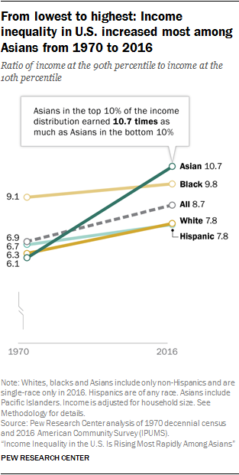Model minority: The stigma around the success
Graphic illustration by Amy Liu
While the model minority myth highlights the academically and financially successful side of Asian Americans, it casts a shadow on the less successful side of the spectrum that is felt by all minorities.
April 21, 2021
Hardworking, smart and obedient. The picture that enters the mind of an average American upon hearing the word “Asian” has changed throughout history, ultimately creating many stereotypes against Asian Americans. One of which, the model minority myth, refers to minority groups that have ostensibly achieved a high level of financial and academic success comparable to that of white Americans, as opposed to other immigrant groups who historically experience less success. Though seemingly positive, many argue that the model minority myth downplays the role that racism and workplace discrimination have in minority achievements in modern U.S. society.
The model minority myth first arose from sociologist William Petersen’s work, in which he characterized East Asian Americans as successful due to their obedience and ability to overcome self-hatred, in the 1960s. In 1966, Petersen published the term “model minority” in a New York Times story titled “Success Story: Japanese American Style”, asserting that Japanese cultures have strong work ethics and family values, qualities that prevent them from becoming a problematic minority. Later that year, a similar article about Chinese Americans was published in the U.S. News & World Report, and the term soon spread to encompass all Asian Americans.
“This discourse about Asian Americans as a ‘model minority’ arose during [the late 1960s], and the consequences of that certainly continue to be felt,” U.C. Berkeley Asian American and Asian Diaspora Studies Program faculty Dr. Lisa Hirai Tsuchitani said. “This discourse continues to portray our community as a monolithic. It really invisiblizes and marginalizes the very diverse migration stories and reasons that [Asian Americans] have been forced to come here or come here on our own, that are oftentimes rooted in very imperialist, colonialist practices by the U.S..”

Success statistics show that 49% of Asians have a bachelor’s degree or higher, a little less than twice the 28% U.S. average, but what studies fail to address is the astronomical wage gap within Asian communities. The jump from the American success rates to the Asian success rates is high, but even higher is the jump from lower-class Asians to the stereotype of the rich Asian. Generalization within minorities and other categories particularly affects Asian immigrants, given that the Asian continent hosts an incredible amount of diversity in appearance, languages, culture and traditions. Activists argue that not only categorizing Asian immigrants as successful and rich, but also generalizing different ethnicities as one, are huge issues.
“People use data in multiple ways to prove multiple points,” Dr. Tsuchitani said. “And when you think about how incredibly diverse the AAPI community is, it’s problematic sometimes to think about our community needs in aggregate and understand those needs in aggregate based on data that does not disaggregate those experiences. More specifically, Pacific Islander and Southeast Asian communities, for example, are not well served by discourses that do not recognize the real economic, political and social challenges that those communities continue to face.”
Another contributing factor to Asian immigrants being perceived as the model minority is their overemphasized intelligence. In past decades, many Asians have immigrated through their degrees from prestigious colleges to attend graduate programs in America. However, this selective process of only choosing the most academically successful undergraduates contributes to a generalization that all Asian immigrants are smart.
Focusing on the importance of Asian contributors in the economic markets and business world seems positive, but a problem within the model minority myth arises when Americans begin to compare success and failure rates of different races. This seemingly-innocent act often results in a system of attributing traits of intelligence and obedience to certain races, while immediately labeling others as lazy, poor and violent and eventually directly leading to racism and discrimination. Derogatory comments aimed toward minority communities often directly feed off of the stereotypes created in this comparison, using Asians as the model minority as a standard to compare every other race to.
“When you say to other communities that are being terrorized and racialized and are hurt in so many other ways that are more explicit, it’s easy for those in power to use the example of, ‘Oh, look at Asian people, why can’t you be as successful as them?’” U.C. Davis freshman Nicole Ong said. “It’s easy for those in power to say, ‘There is no racism in America because there’s a minority that is doing fine.’”
While Asian success rates are higher than Black success rates purely in numbers, that success does not necessarily apply to each Asian or Black American individually. Other possible factors that play a role in these statistics are the level of systematic racism most Black communities and students need to overcome and the school-to-prison pipeline. In fact, using the model minority as a measuring tape for other minorities directly pitches various people-of-color communities against each other. White Americans are often found perpetuating the myth as a way to pick up the Asian community by attempting to prove that White people are not the only race that can succeed in America. However, this encourages the ignorance of deep-set discrimination within economic systems and workplace etiquette, furthering the initial stereotype that all other minorities must be too lazy to put in the work.
“It doesn’t mean that one has to be solved first, and it doesn’t mean that one is more important than the other,” Ong said. “This isn’t to say one group has it better or worse or that Asian people have it better or worse. It is unproductive and unfair and, frankly, very harmful to imply that you can only stand with one community, when we can and should be standing with both.”
Despite how it affects other minority communities in America, the model minority myth seems to be a bargaining chip for Asian Americans. In practice, however, it is the exact opposite and instead traps young Asians into aiming for perfect grades, STEM-related careers and a constant boiling pot of stress and identity issues from a young age.
“In the Bay Area, where it’s an [Asian majority], a lot of us have perpetuated [the model minority myth] ourselves, in the sense that we expect each other to go into STEM, or we expect each other to be good at math or science,” freshmen Niharika Emani said. “We need to stop making those assumptions.”
This stereotype is perpetuated not only by society and economic ebb and flow, but also by daily familial interactions. The stereotype of the “smart, rich, studious Asian” is passed on by parents who seem to only want the best for their children — meaning a high GPA, prestigious university, and the highest-paying jobs of a lawyer, doctor or engineer. At first glance, this sounds like a precious sentiment instead of the crippling, painfully unreal myth it is. Looking back at a generation of immigrants, the shoulders that the model minority is placed on were of those coming to America with only the goal of becoming successful and holding their children to similar standards.
Beginning with the Chinese Exclusion Act, no more than two positions for Asian Americans were formed. This Act played a major role in the “fresh off the boat” perspective of Asian-Americans, constantly differentiating them from other minorities and painting them in a negative light. However counterintuitive, it can be argued that the Repeal Chinese Exclusion Act also played into the separation of Asian-Americans from other groups. Because the purpose was to decrease stigma against Asians and to begin to trust them with jobs and housing, it brought up the stereotype of “law-abiding, peace-loving, courteous people living quietly among us,” thus kicking off the model minority myth.
“On one hand, we’re pictured as the smart kids in the class,” Ong said. “We get A’s on every test, we’re solving all these problems. Then there’s the other dynamic of, we don’t speak any English, we’re a comedy point because of a thick accent, we have yellow skin and very slanted eyes.”
Hollywood’s portrayal of Asians has also fed into the model minority myth. Asians, predominantly East Asians, are often seen as supporting characters with the inability to speak English fluently that are the main character’s wise mentor or the nerd in the classroom. For example, main character Ravi Ross in American teen family sitcom “Jessie” is representative of a stereotypical Asian who is smart and unathletic and stresses about receiving A’s on every test. The spinoff of “Jessie,” “Bunk’d,” features main character Tiffany Chen, a young camper of Chinese descent who tries to please her strict parents with good grades and chooses to study instead of having fun.
“It starts from [Ravi] and from a young age, people are probably thinking that all Indian people are really just study, study, study,” sophomore Tanika Anbuchelvan said. “Then we go on to ‘Bunk’d’: Tiffany wants to be a doctor and has strict parents. She plays the violin, she’s like the early nerdy Asian girl, and then that gets put into people’s minds, so they’re like, ‘Wow, this Asian girl is crazy about her math and her flashcards, so that means every single Asian girl is crazy about her math and her flashcards.’”
Overgeneralizations seem to stimulate the common stereotypes that Asians have dealt with, whether it be between different ethnicities or within the same one. A focus for many activists is to exaggerate the value of Asian-Americans not as the model minority, but rather as unique individuals.
The history of the model minority myth is complex and ever changing. As more Asian activists work to deconstruct the stereotype, the perception of Asians as the model minority might change in coming years.





































































